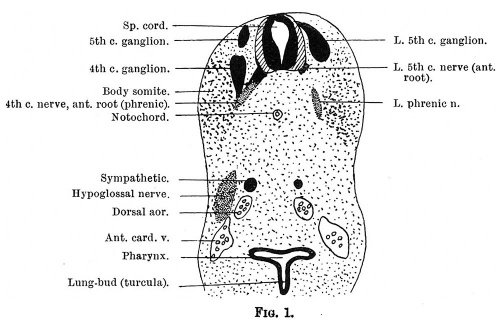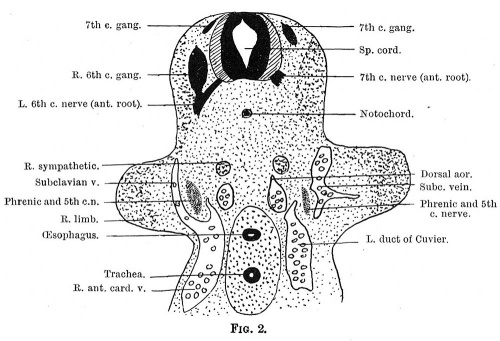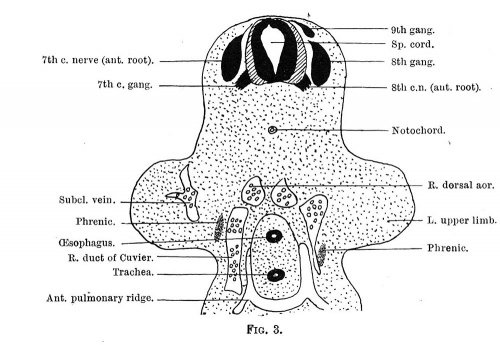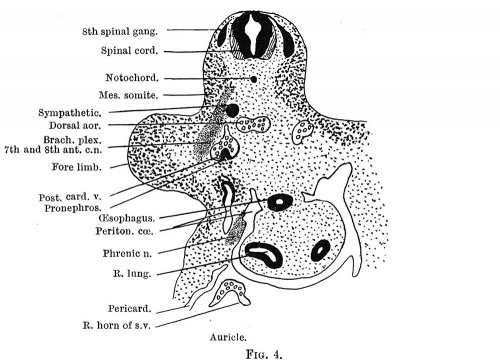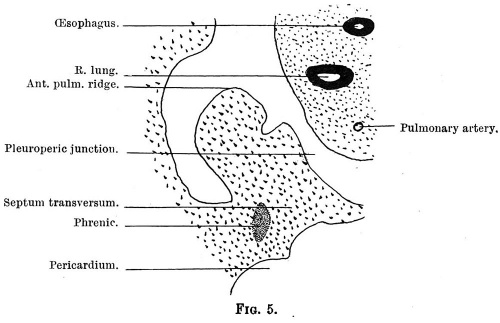Paper - The Course of the Phrenic Nerve in the Embryo
| Embryology - 28 Apr 2024 |
|---|
| Google Translate - select your language from the list shown below (this will open a new external page) |
|
العربية | català | 中文 | 中國傳統的 | français | Deutsche | עִברִית | हिंदी | bahasa Indonesia | italiano | 日本語 | 한국어 | မြန်မာ | Pilipino | Polskie | português | ਪੰਜਾਬੀ ਦੇ | Română | русский | Español | Swahili | Svensk | ไทย | Türkçe | اردو | ייִדיש | Tiếng Việt These external translations are automated and may not be accurate. (More? About Translations) |
Amin M. The course of the phrenic nerve in the embryo. (1914) J Anat Physiol. 48(2): 215-8. PMID 17232992
| Historic Disclaimer - information about historic embryology pages |
|---|
| Pages where the terms "Historic" (textbooks, papers, people, recommendations) appear on this site, and sections within pages where this disclaimer appears, indicate that the content and scientific understanding are specific to the time of publication. This means that while some scientific descriptions are still accurate, the terminology and interpretation of the developmental mechanisms reflect the understanding at the time of original publication and those of the preceding periods, these terms, interpretations and recommendations may not reflect our current scientific understanding. (More? Embryology History | Historic Embryology Papers) |
The Course of the Phrenic Nerve in the Embryo
By M. Amin, Assistant Professor of Anatomy, School of Medicine, Cairo.
The phrenic nerve is a valuable structure in the embryo, for several reasons. Its fibres reach their termination—and hence the whole course of the nerve can be traced—at an earlier date than do the fibres of any other spinal nerve; and from the relation which the nerve presents to the pleura and pericardium, as well as to the diaphragm, it is of great service in tracing the development of these different portions of the coelom, as well as the early stages of the development of the diaphragm.
The nerve cannot apparently be traced in embryos of less than 5 mm. maximum length, and in the following account a description is given, with figures, of the origin, course, and termination of the nerve as it was found in a 6 mm. embryo.
Description of the Right Phrenic Nerve
Beginning with a transverse section at the level of the fourth cervical ganglion (fig. 1), the nerve was found arising from the anterior roots of the fourth cervical nerve as the latter takes origin from the spinal cord.
Fig. 1.
Placed lateral to each nerve (on the right and left sides of the embryo) is the remains of a somite.
As the nerve is traced downwards, it passes ventrally, and comes to lie behind the anterior cardinal vein; and at a still lower level it establishes a communication with the fifth cervical nerve, and comes to lie in a cup-shaped invagination at the junction of the anterior cardinal vein with the primitive subclavian vein from the limb bud (fig. 2).
Fig. 2.
The relationship at this level is that the nerve is mesial to the sub-clavian vein, for that vessel lies more in a dorso-ventral axis than in the coronal plane. In sections beyond this level, the nerve retains a similar position, and then comes to lie lateral to the duct of Cuvier (fig. 3).
Fig. 3.
Further on, the nerve comes into relation with the early divisions of the coelomic cavity, and lies between the antero-lateral recess laterally and the pleuro-pericardial passage medially (fig. 4).
Fig. 4.
The position of the nerve at this level is important, as the nerve is now coming to lie in the upper part of the arch connecting the anterior and posterior pulmonary ridges; but at this stage the nerve lies lateral to the lung bud, and posterior to the pericardial sac.
From the figure, evidence is afforded of the very extensive changes which occur at a later stage in connexion with the development of the lungs. In order to attain the adult relationships, the lung buds must at a later stage grow laterally, behind the phrenic nerve, and finally send their anterior parts forwards, with the investing pleura, and so entirely alter the relationship present at this stage of embryonic life.
In sections below this level the nerve is found to terminate among the cells of the ventral aspect of the septum transversum, with the pericardium anterior and mesial and the anterior pulmonary ridge posterior to it (fig. 5).
Fig. 5.
The figures illustrating the course of the nerve are obtained from projection drawings of sections at the various levels.
Lastly, I have to express my great thanks to Professor David Waterston of King’s College, who kindly helped me much in working out this nerve, which I did in his laboratory at the King’s College, London.
Cite this page: Hill, M.A. (2024, April 28) Embryology Paper - The Course of the Phrenic Nerve in the Embryo. Retrieved from https://embryology.med.unsw.edu.au/embryology/index.php/Paper_-_The_Course_of_the_Phrenic_Nerve_in_the_Embryo
- © Dr Mark Hill 2024, UNSW Embryology ISBN: 978 0 7334 2609 4 - UNSW CRICOS Provider Code No. 00098G


